Xylophanes chiron nechus
|
|
Updated as per
AN ANNOTATED CHECKLIST OF THE SPHINGIDAE OF BOLIVIA, October 2007
Updated as per http://www.pybio.org/SPHINGINAE.htm (Paraguay), October 2007
Updated as per personal communication with Ezequiel Osvaldo Núñez Bustos, Argentina, March 2008
Updated as per personal communication with Ezequiel Bustos (Aguas Blancas, Salta, Argentina, 405m); December 2009
Updated as per CATE Sphingidae (Brazil, Petropolis); April 20, 2011
Updated as per personal communication with Andres Urbas (Camp Caiman near Kaw, French Guiana, April 1, 2011); May 7, 2011
Updated as per personal communication with Larry Valentine (Itanhandu, Minas Gerais, Brazil, October 14, 2011); October 16, 2011
Updated as per personal communication with Humberto Calero Mejia (92mm, Isla Gorgona, Cauca, Colombia, June 5, 2011; 0m); December 20, 2011
Updated as per personal communication with Ezequiel Bustos (Shilap revta. lepid. 43 (172) diciembre, 2015, 615-631 eISSN 2340-4078 ISSN 0300-5267), January 4, 2016
Updated as per personal communication with Lamirez Silva (nar Rio de Janeiro, Rio de Janeiro, Brazil, September 12, 2016); September 12, 2016
Updated as per personal communication with Kelsey J.R.P. Byers (Gamboa, Panama); April 19, 2018
Updated as per personal communication with Gernot Kunz (El Copan, Cartago, Costa Rica, March 6, 2019, 1047m); April 16, 2019
Updated as per personal communication with Andie Huelunlef Alonso (Parque Macona, Misiones, Argentina, April 24, 2019); April 24, 2019
Updated as per personal communication with Luis F. Alberti (mature larva, Santa Rita do Sapucai, Minas Gerais, Brazil, March, 2019); July 23, 2019
Updated as per personal communication with Francierlem Oliveira (Rio Grande do Norte, Brazil, August 30, 2020); August 31, 2020
|
Xylophanes chiron nechus
zail-AH-fan-eesMKYE-ronM NECK-uhs
(Cramer, 1777) Sphinx
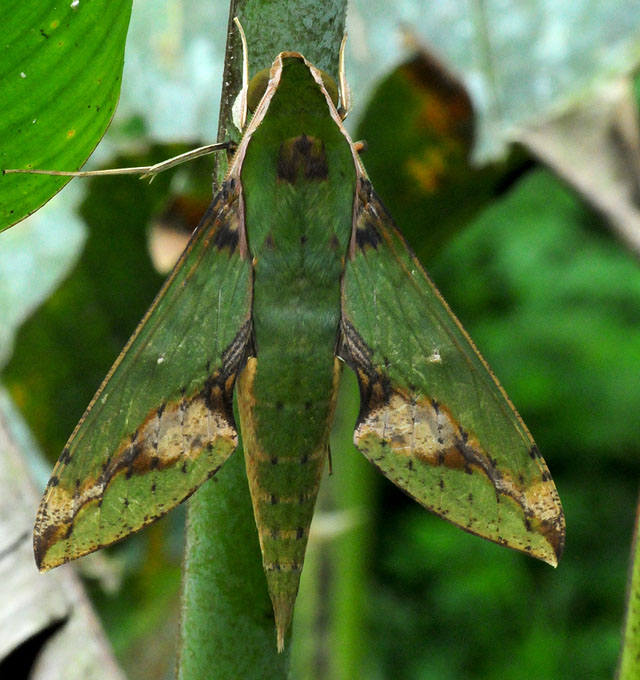
Xylophanes chiron nechus, Misahualli, Napo, Ecuador, March 3-4, 2009, courtesy of Steve Ife.
This site has been created by Bill Oehlke
Comments, suggestions and/or additional information are welcomed by Bill.
TAXONOMY:
Family: Sphingidae, Latreille, 1802
Subfamily: Macroglossinae, Harris, 1839
Tribe: Macroglossini, Harris, 1839
Genus: Xylophanes Hubner [1819] ...........
Species: chiron nechus (Cramer, 1777)
|
DISTRIBUTION: Xylophanes chiron
nechus (wingspan: approximately 92mm) fly in the West Indies (specimen type locality),
and also occur in
Colombia: Cauca: Isla Gorgona (0m, HCM);
Ecuador: Napo; Misahaulli;
French Guiana: Kaw;
Bolivia:
Santa Cruz: Potrerillos del Güendá; Florida, Mataral; Pampa Grande;
Ichilo, La Víbora; Buena Vista; Sarah;
La Paz: Murillo, Cota Cota; Zongo, Cuticucho;
Beni: Espíritu, Cabaña;
Cochabamba: Carrasco, Chapare;
Brazil: rio de Janeiro: Petropolis and Rio de Janeiro; Minas Gerais: Itanhandu and Santa Rita do Sapucaia (LFA); Rio Grande do Norte (FO);
and
Paraguay:
Concepcion, San Pedro, Canindeyu, Alto Parana, Cordillera, Central,
Paraguari, Guaira, Caaguazu, Caazapa, (probably Itapua (WO??));
northern Argentina: Misiones, Salta (405m EB), (Buenos Aires, Corrientes, Entre Rios, Tucuman (EB)). |
Choerocampa druryi Boisduval, [1875], Jamaica, is same as Xylophanes chiron nechus .
It is also reported in Mexico and Belize. The moth is probably very
widespread in its range, and it flies throughout Central America, at least in the east coast countries.
Gernot Kunz reports a March flight in El Capon, Cartago, Costa Rica.
X. c. nechus, December 23, 2005, Misiones Province, near
Puerto Iguazu, near light at night, courtesy of Oz Rittner. | 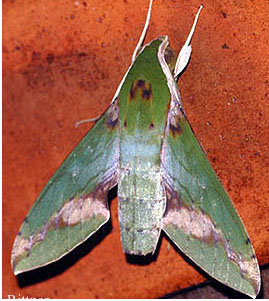 |
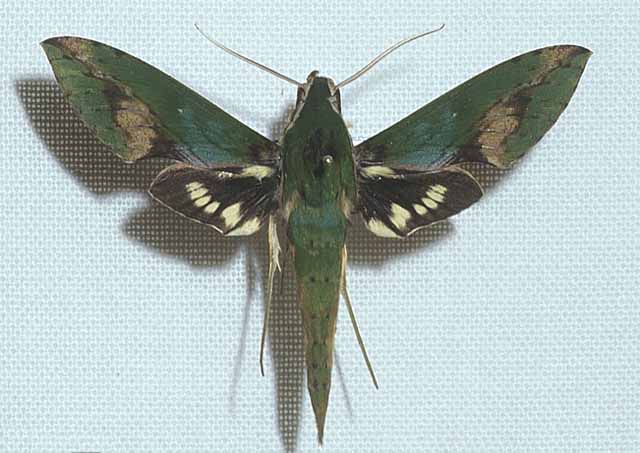
Xylophanes chiron nechus male, courtesy of Hubert Mayer
copyright.
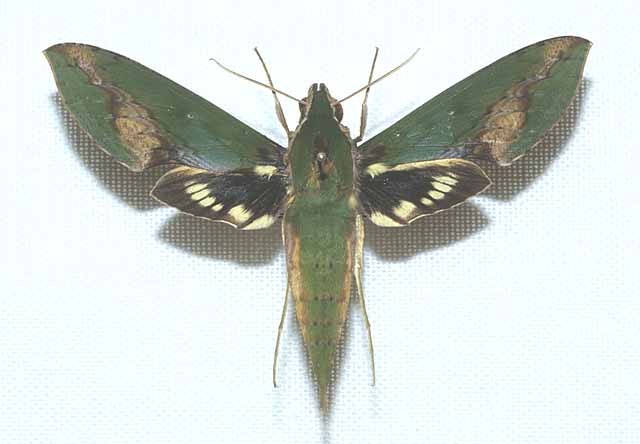
Xylophanes chiron nechus female, courtesy of Hubert Mayer
copyright.
CATE: "Very similar to Xylophanes chiron chiron but brown pattern elements of forewing upperside better developed. Moths in which the
ground colour is brown rather than green do occur but are very rare.
"Pale brown scaling along fourth postmedian line more strongly developed, in particular the patch running from M2 to the inner margin is broader and more
ovate rather than narrowly triangular."
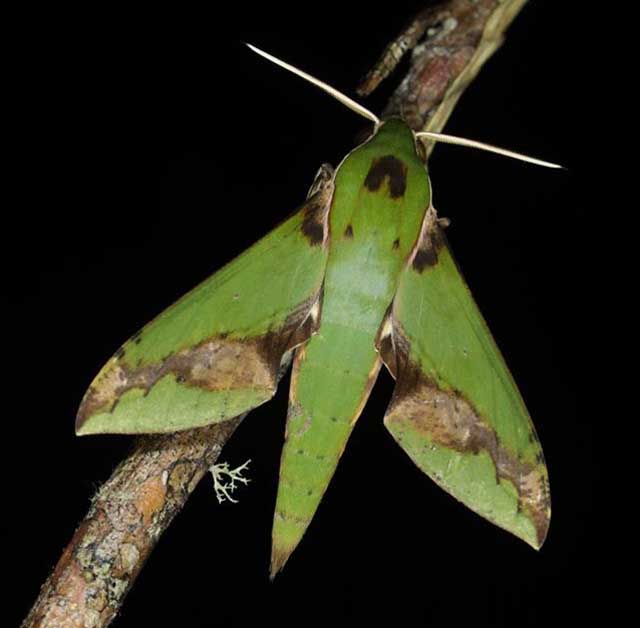
Xylophanes chiron nechus??, Dominican Republic,
courtesy of Jean Haxaire.
FLIGHT TIMES:
Xylophanes chiron nechus adults
have been taken in December in Argentina. Ezequiel Osvaldo Núñez Bustos
reports a February flight in Misiones Province, Argentina. There are probably multiple
broods elsewhere. Andres Urbas confirms an April 1, 2011, flight near Kaw, French Guiana.
Larry Valentine reports a mid October flight, 2011, in Itanhandu, south eastern Minas Gerais, Brazil.
Humberto calero Mejia reports a June 5, 2011 flight on Isla Gorgona, Cauca, Colombia.
Visit Xylophanes chiron nechus, Itanhandu, Minas Gerais, Brazil, courtesy
of Larry Valentine.
Visit Xylophanes chiron nechus recto and verso, Isla Gorgona, Cauca, Colombia, June 5, 2011,
courtesy of Humberto Calero Mejia.
Visit Xylophanes chiron nechus (recto and verso), near Rio de Janeiro, Rio de Janeiro, Brazil,
September 12, 2016, courtesy of Jamirez Silva.
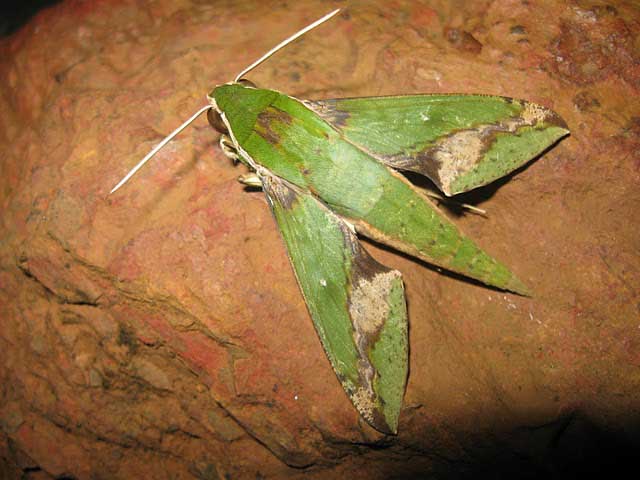
Xylophanes chiron nechus, Camp Caiman, near Kaw, French Guiana,
April 1, 2011, courtesy of Andres Urbas.
Xylophanes chiron nechus has been recorded on the wing in every month in Costa Rica. There are at least three broods in Peru: January-February, June-July, and October. I have seen images of
subspecies nechus from Merida, Venezuela, in mid January.
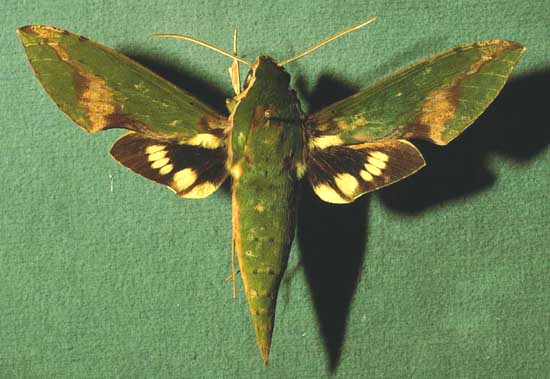
Xylophanes chiron nechus male courtesy of Dan Janzen.
ECLOSION:
Pupae probably wiggle to surface from subterranean chambers just prior to eclosion.
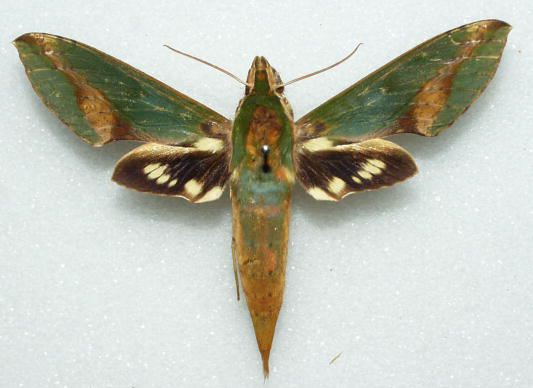
Xylophanes chiron nechus male, Mexico, courtesy of
Manuel Balcazar-Lara.
>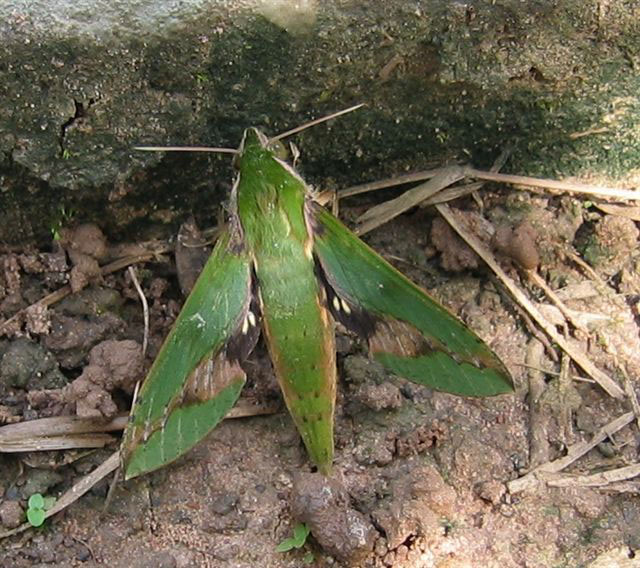
Xylophanes chiron nechus female, courtesy of Eurides Furtado.
SCENTING AND MATING:Females call in the males with a pheromone released from a gland at the tip of the
abdomen. Males come in to lights very readily, but females are seldom taken in that way.
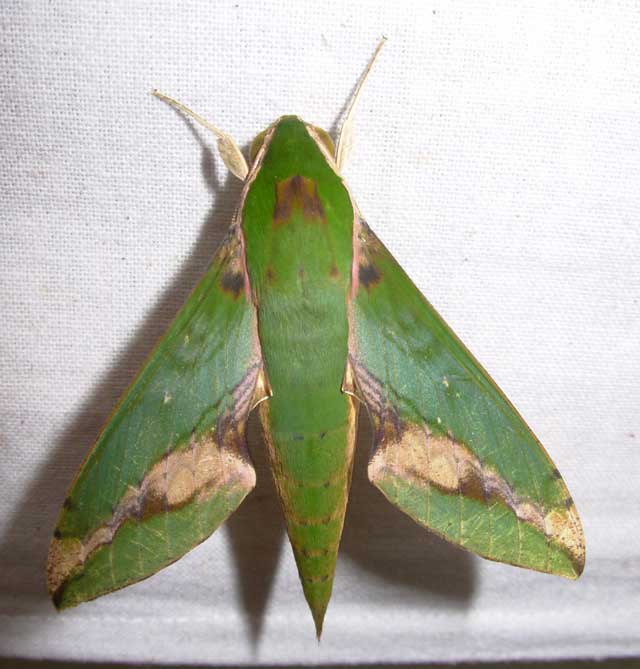
Xylophanes chiron nechus, Yacutinga Private Reserve, Misiones Province,
(near border between Argentina and Brazil), February, 2008
courtesy/copyright of Ezequiel Osvaldo Núñez Bustos.
EGGS, LARVAE, PUPAE:
Larvae probably feed on Psychotria panamensis and Psychotria nervosa of the Rubiaceae family and on
Pavonia guanacastensis of the Malvaceae family.
Kelsey J.R.P. Byers reports finding a pupa in a leaf under Psychotria poeppigiana in Gamboa,
Panama.
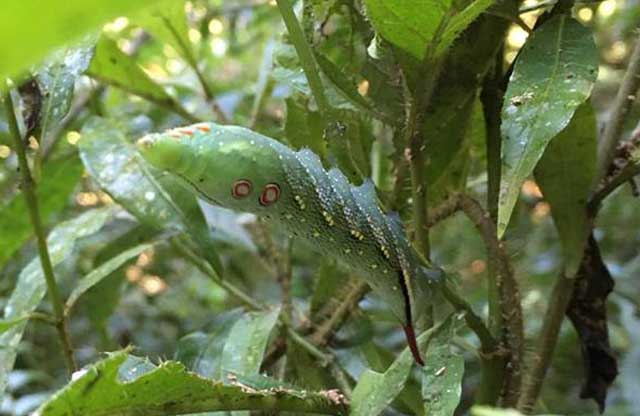
Xylophanes chiron nechus final instar, Parque Macona, Misiones, Argentina,
April 24, 2019, courtesy of Andie Huenulef Alonso.
The larva directly above is feeding on Psycotria viridis, (Chacruna), which is used in making Ayauaska tea, according to Geraldo Salgado.
Eurides Furtado reports the natural hostplant in Brazil is Rudgea viburnoides (Cham.) Benth. (Rubiaceae), and the larval and pupal images below are
courtesy of Eurides.
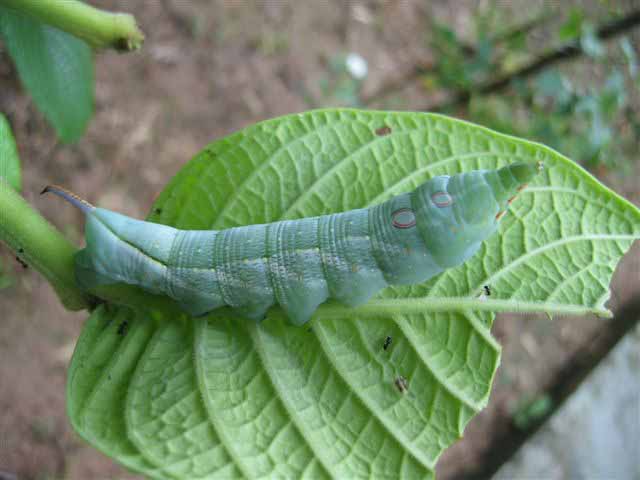
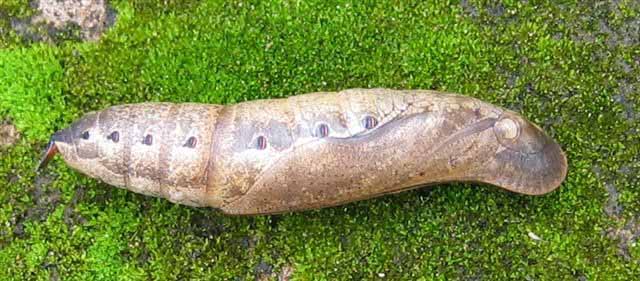
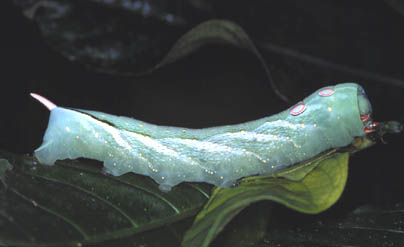
Moths emerge from pupae in 17-35 days. Larva and pupa images courtesy of Dan Janzen.
| 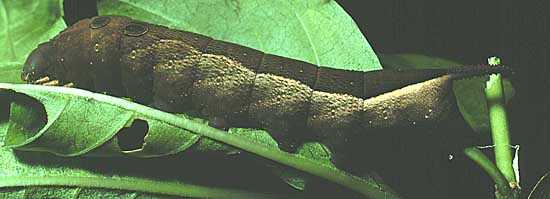
Moths emerge approximately one-two months after larvae pupate. |
Kelsey J.R.P. Byers provides the following images from Panama. There are additional images of pupa and moth from Kelsey via this
Xylophanes chiron chiron link.
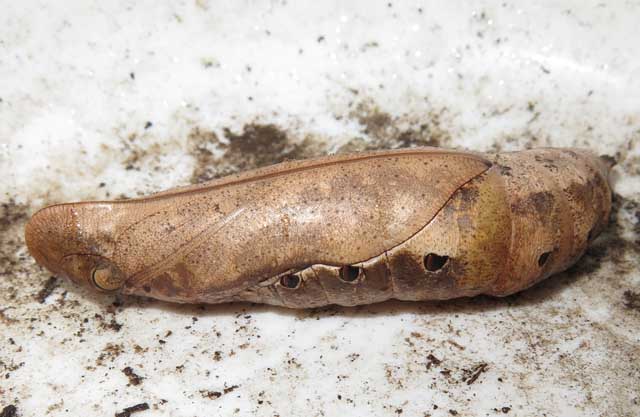
Xylophanes chiron chiron/nechus pupa, Gamboa, Panama,
courtesy of Kelsey J.R.P. Byers.
Kelsey indicates he found the pupae in a slightly rolled, dried leaf. Probably this species pupates in leaf litter instead of excavating a subterranenan chamber.
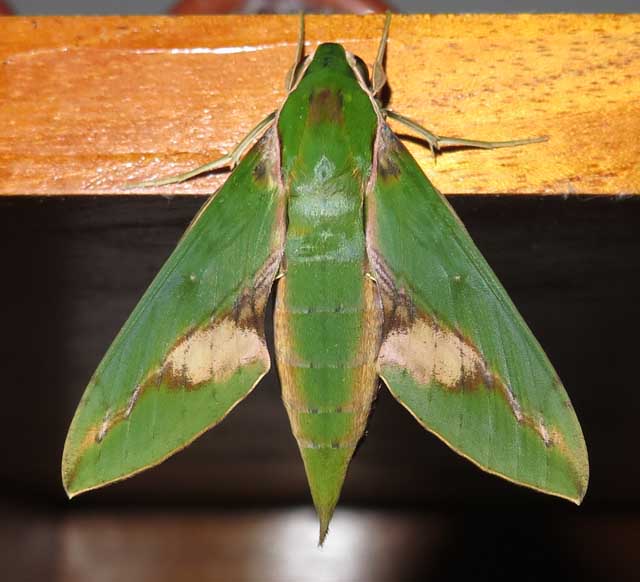
Xylophanes chiron chiron/nechus adult, Gamboa, Panama,
courtesy of Kelsey J.R.P. Byers.
Kelsey's image of the adult moth seems intermediate between nominate chiron and chiron nechus.
Use your browser "Back" button to return to the previous page.
Goto Main Sphingidae Index
Goto Macroglossini Tribe
Goto Central American Indices
Goto Carribean Islands
Goto South American Indices
Goto U.S.A. tables
Visit Xylophanes chiron nechus, additional images.
The pronunciation of scientific names is troublesome for many. The "suggestion" at the top of the page is
merely a suggestion. It is based on commonly accepted English pronunciation of Greek names and/or some
fairly well accepted "rules" for latinized scientific names.
The suggested pronunciations, on this page and on other pages, are primarily put forward to assist those who hear with internal ears as they read.
There are many collectors from different countries whose intonations and accents would be different.
Jean Marie Cadiou writes, "When I say "Xylophanes" in English I pronounce it something like "Zailophanees", with the emphasis on the
"o". The French pronounce it differently, something like "Kzeelophaness" with no emphasis, and the Germans yet in a different way..."
In Greek myth, Phanes is the golden winged Primordial Being who was hatched from the shining Cosmic Egg that was the source of the
universe. He personifies light emerging from chaos.
"Xylo" is the Greek word for wood.
The specimen type for the genus Xylophanes is Xylophanes anubus. Perhaps ? when Hubner
examined this species, the yellow-orange and brown tones of the forewings suggested wings of wood.
The species name "chiron" comes from Greek mythology where Chiron is the wise centaur who
tutors Achilles, Hercules and Asclepius. I do not know the source of the subspecies name.
This website has been created and is maintained by Bill Oehlke without government or institutional financial assistance. All expenses, ie., text reference
support material, webspace rental from Bizland, computer repairs/replacements, backups systems, software for image adjustments (Adobe Photoshop; L-View),
ftp software, anti-virus protection, scanner, etc. are my own.
I very much appreciate all the many images that have been sent to me, or of which I have been granted permission to copy and post from other websites.
All images on this site remain the property of respective photographers.
If you would like to contribute to the maintenance of this website by sending a contribution to
Bill Oehlke
Box 476
155 Peardon Road
Montague, Prince Edward Island, C0A1R0
Canada
your donation would be much appreciated and would be used for
1) paying for webspace rental;
2) paying for computer maintenance and software upgrades;
3) purchases of additional text reference material (journals and books) in anticipation of expanding the site to a worldwide Sphingidae site;
4) helping to pay my daughter's tuition (completed spring 2013); with anything left over going to humanitarian aid.
If you are mailing a check from USA, please use $1.25 postage $1.15 (2014 rate); $1.25 (2015 rate).
















